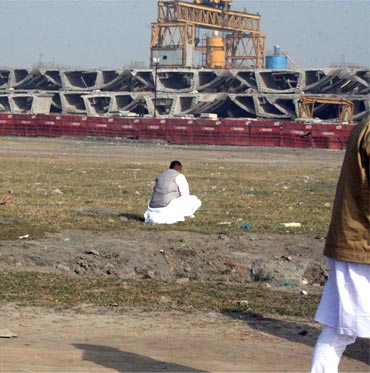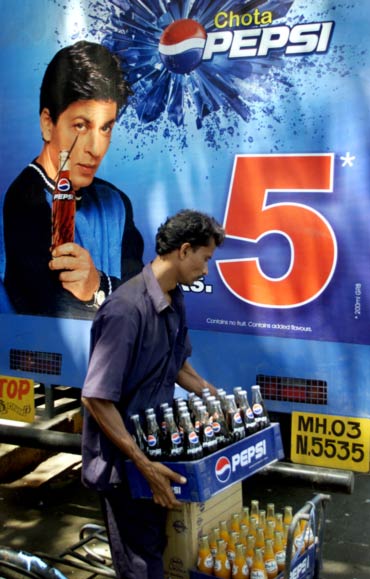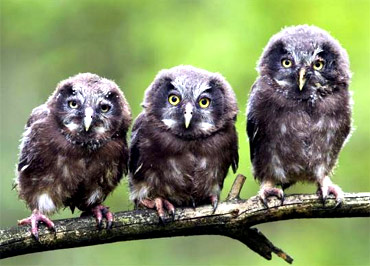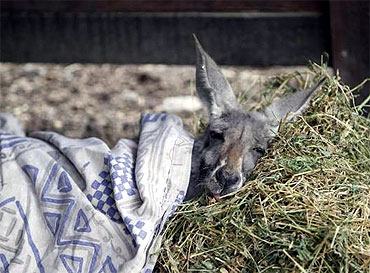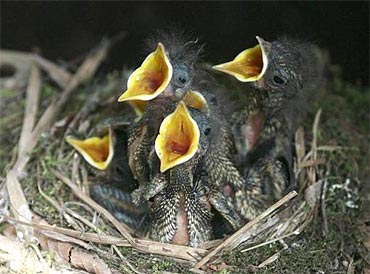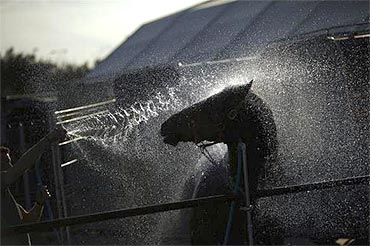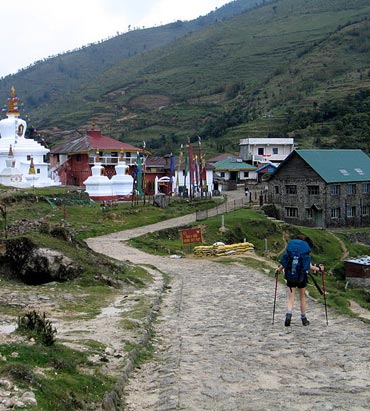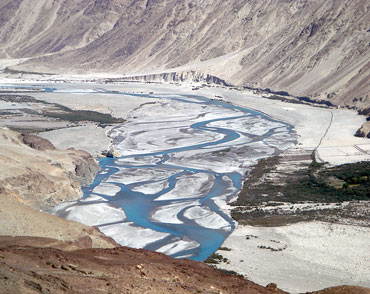This photograph was clicked on the way to Ahmednagar from Pune," says Arunendra Mishra. "It depicts the true colours of rural India. The location forced us to stop and have a glimpse of the children having fun and working together."
@REDIFF
Top mobile phones you can't live with
Friday, December 31, 2010
9. Our complete lack of civic sense
Think about it. If a day passed without you seeing a single paan-stain, something wouldn't feel right. It would actually bother you. Mainly because we're a nation with no civic sense whatsoever.
Spitting up everywhere, littering the streets with everything imaginable, blowing our noses without handkerchiefs, peeing on any sidewalk we please -- it paints an ugly picture, but we are like that -- you know how it goes by now.
8. Pepsies that are not manufactured by, well, Pepsi
Remember what we said about you being a weenie if you didn't play gallicricket or try ice gola?
We're willing to take that back (well -- half of it anyway), if you haven't been deprived of pepsies as a kid. No, not the aerated drink; the little ice candies that come in an assortment of flavours like orange, pineapple andkala khatta
7. Bargains
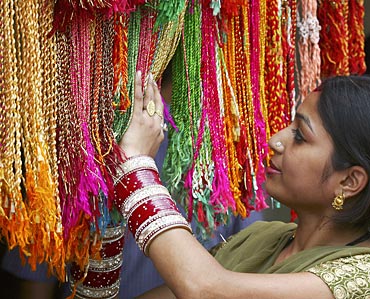 Sure, we rave about our state-of-the-art malls and their plush offerings, but the truth is that it's more fun doing rasta-shopping.
Sure, we rave about our state-of-the-art malls and their plush offerings, but the truth is that it's more fun doing rasta-shopping.Before the term gets you thinking of Bob Marley, you wannabe Amriki, let us clarify that we mean street bargains at roadside stalls and flea markets.
Bargaining runs in our blood. And when someone compliments a purchase, even five years down the line, we remember to say, "You know, he was not coming down only from Rs 500. But finally I got it for Rs 300 what a bargain, isn't it?"
6. Street food
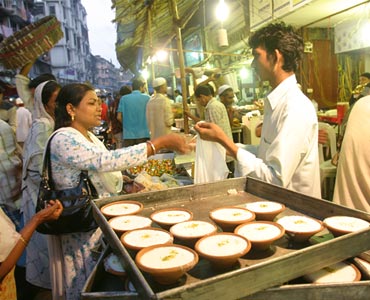 Vada pao, sev puri, momos, dosas -- slurrrp!
Vada pao, sev puri, momos, dosas -- slurrrp!Hygiene be damned -- we love our street food and some of us actually prefer it to fancy meals in posh restaurants.
Forget the fact that most of the plates we eat in are merely dipped in a bucket of repeatedly used water by way of washing, or that we find the odd hair in our food now and then. It's worth it!
5. Paanwalas
 The paanwala is an honourable Indian institution. And of course, they don't just sell paan -- you'll find they have everything from little toys to tea, magazines and bubblegum.
The paanwala is an honourable Indian institution. And of course, they don't just sell paan -- you'll find they have everything from little toys to tea, magazines and bubblegum.It's an adda, a hangout for men of all ages, where they convene at various times through the day. At any given point you'll see at least three males hanging about, enjoying a cigarette before heading to work, buying a few mints after lunch or tucking into a paan outside the office.
4. Item songs
 Our country thrives on item songs and the -- er -- 'items' that feature in them.
Our country thrives on item songs and the -- er -- 'items' that feature in them.All the curvy Munnis and Sheilas of the film fraternity are enough to have any hot-blooded male on edge in theatres.
And let's face it, while we keep talking about the degradation of 'Western' culture, we're all perfectly aware of erotica in Indian history, right from theKama Sutra to the comely courtesans who were at the beck and call of royalty in centuries gone by.
2. Bullock carts in the middle of metros
1. Saas-bahu soaps
All the women go to bed completely decked out in embroidered saris and wake up without a single hair out of place.
The evil ones inevitably wear coloured contact lenses and heavy makeup, while the good ones are so meek, so downtrodden, so sacrificing that you want to pull your own hair out at their goody-two-shoes antics.
 They worship their no-good, drunkard husbands and bullying in-laws and pray before the family idol each day, bathing it in their pure tears as they beseech the Almighty (who may want to keep a bucket handy, considering the diabetic tripe He's forced to hear) to bring about a change in their lives.
They worship their no-good, drunkard husbands and bullying in-laws and pray before the family idol each day, bathing it in their pure tears as they beseech the Almighty (who may want to keep a bucket handy, considering the diabetic tripe He's forced to hear) to bring about a change in their lives.No matter how out of sync they are with reality or how offensive they are to modern, independent women with a shred of self-respect, we will continue to watch and enjoy saas-bahu soaps forever.
And so will those dominating wives who don't hesitate to club their hubbies over the head with a frying pan every now and again -- even they're rooting for the hapless bahus and clucking in sympathy while quiet moans emanate from a corner where someone's bid to watch cricket was once again vetoed with a vessel.
Thursday, December 30, 2010
Here we have an entry from Satya N Govind (Chari), who describes himself as a professional scriptwriter/cartoonist and a photographer.
"I prefer to call myself a 'nuisance dedicated to creativity," he explains. "I have been enjoying every moment of this year writing, sketching and clicking and finally had the opportunity to click a plethora of photos while I was travelling in India. Be it the divine abode of the Lord of the Seven Hills (Tirupati) or a never-to-miss-moment in my home town, New Delhi, these pictures aren't merely pictures but stories churned with a purpose."
"This picture was shot at the New Delhi railway station, depicting the predicament of this young boy caught in the rain that had lashed the city several times. While he stood there covering his head, his sibling got candid."
@REDIFF
@REDIFF
Nujum H of Noida sent in this photograph, saying, "I travelled from Delhi to Bharatpur (Rajasthan) this month to take pictures of migratory birds. Though Bharatpur Bird Santuary is a heaven for shutterbugs during the winter season, this picture clicked by me inside the santuary stands apart. These three students walked ahead of their group to spot the birds. The sun rays crossing through the dark, misty tree leaves gave this picture an unusual feeling."
@REDIFF
@REDIFF
I have this image from Ankush Kumar, who explains, "This pic was taken on the outskirts of Chandigarh. We had stopped for some shopping and two children came to our car looking for something to eat. As my wife opened the bag to get some food, they were eager to know what they were going to get."
@REDIFF
@REDIFF
Wednesday, December 29, 2010
Eau d’Hadrien By Annick Goutal Perfume Review
Articles by: ida
I came across the brand Annick Goutal while searching online for new perfumes to try. I found that many people professed a great love for their perfumes and had a certain reverence for this perfume house, and I became quite curious about it. So on my birthday off I went, at the height of summer in sweltering heat and humidity, to sniff at the Annick Goutal line, and came home with Eau d’Hadrien as a present.
Article by ANGEL
These photos are from the recent Mumbai police show 2010 event.
I only like Rani mukherjee’s saree and bangles. Makeup not to much.
by- Sneha
I was randomly checking out January’s issues of Vogue and I came across these tips by Sonam Kapoor (an Indian actress). Nothing that you wouldn’t have heard or read before. I thought I’d share it as a reminder to all of us. 

Ten tips to get the body you want by Sonam Kapoor:
1. Don’t eat that samosa.
2. Eat small meals, every two hours, instead of three big meals.
3. Stay away from refined foods. Eat lots of fruit and vegetables, and lean meats.
4. Exercise.
5. Cut down on caffeine and drink more water. Green tea has the caffeine you need, so switch from coffee.
6. Accept that there can be no excuse for straying from your regime.
7. Put on music and dance.
8. Recognise that there is no easy way.
9. Don’t be a lazy bum. You only need six hours of sleep. Get up and get moving.
10. Never be unhappy with who you are, but do see where there may be room for improvement.
1. Don’t eat that samosa.
2. Eat small meals, every two hours, instead of three big meals.
3. Stay away from refined foods. Eat lots of fruit and vegetables, and lean meats.
4. Exercise.
5. Cut down on caffeine and drink more water. Green tea has the caffeine you need, so switch from coffee.
6. Accept that there can be no excuse for straying from your regime.
7. Put on music and dance.
8. Recognise that there is no easy way.
9. Don’t be a lazy bum. You only need six hours of sleep. Get up and get moving.
10. Never be unhappy with who you are, but do see where there may be room for improvement.
Friday, December 17, 2010
Bollywood's hits vs. Flops
What has the year 2010 been like for top stars?
This new year's eve, there will not be any champagne-popping parties at most bollywood homes. The cold wave of flops has the film fraternity in its chilly grip. The industry that pumped crores into film this year can count its hits, just five to be precise: "dabangg", "golmal3", "My name is khan", "rajneeti", and "housefull".
Needless to say most actors are moping about their fate in 2010. Ajay devagn, the actor with most no. Of releases this year, is enough to celebrate about with the birth of a son and hit filled year. None other actor and none of the actresses either have been able to match that success. Deepika padukone and Aishwarya rai clocked the most no. Of releases this year, four each, and just one hit to their name. On the flop-o-meter hrithik roshan was the most ill fated with both his big ticket releases biting the dust.
On the weighing scale of hits vs. Flops, we check out what 2010 doled out to our performers......
To be continued in next post......
This new year's eve, there will not be any champagne-popping parties at most bollywood homes. The cold wave of flops has the film fraternity in its chilly grip. The industry that pumped crores into film this year can count its hits, just five to be precise: "dabangg", "golmal3", "My name is khan", "rajneeti", and "housefull".
Needless to say most actors are moping about their fate in 2010. Ajay devagn, the actor with most no. Of releases this year, is enough to celebrate about with the birth of a son and hit filled year. None other actor and none of the actresses either have been able to match that success. Deepika padukone and Aishwarya rai clocked the most no. Of releases this year, four each, and just one hit to their name. On the flop-o-meter hrithik roshan was the most ill fated with both his big ticket releases biting the dust.
On the weighing scale of hits vs. Flops, we check out what 2010 doled out to our performers......
To be continued in next post......
Thursday, December 16, 2010
ALBUM: The best wildlife photos of 2010
We bring you a collection of best wildlife photos of 2010 taken around the world.
A lion yawns at a nature reserve on the outskirsts of Pretoria, South Africa June 29, 2010.
Boreal owl chicks sit on a tree branch in a forest on the outskirts of Minsk, Belarus.
Orangutan 'Harapan' plays with a pumpkin during a 'Halloween-breakfast' in its enclosure at the Hagenbeck Zoo in the northern German city of Hamburg.
Angelina, a seven-year-old Red Kangaroo, rests after receiving treatment for lumpy jaw disease at the Gan-Garoo Australian park, which features wildlife from Australia, near Kibbutz Nir David in northern Israel.
An African penguin swims in his pool at the Servion Zoo in Servion near Lausanne, Switzerland.
Ostriches look through a fence at an ostrich farm in the village of Yasnogorodka, some 50 km west from Kiev.
A White Peacock (Anartia Jatrophae) butterfly, a native of North and Central America, clings to a plant at the American Museum of Natural History's Butterfly Conservatory exhibit in New York.
A lion yawns at a nature reserve on the outskirsts of Pretoria, South Africa June 29, 2010.
Boreal owl chicks sit on a tree branch in a forest on the outskirts of Minsk, Belarus.
Orangutan 'Harapan' plays with a pumpkin during a 'Halloween-breakfast' in its enclosure at the Hagenbeck Zoo in the northern German city of Hamburg.
Angelina, a seven-year-old Red Kangaroo, rests after receiving treatment for lumpy jaw disease at the Gan-Garoo Australian park, which features wildlife from Australia, near Kibbutz Nir David in northern Israel.
An African penguin swims in his pool at the Servion Zoo in Servion near Lausanne, Switzerland.
Ostriches look through a fence at an ostrich farm in the village of Yasnogorodka, some 50 km west from Kiev.
A White Peacock (Anartia Jatrophae) butterfly, a native of North and Central America, clings to a plant at the American Museum of Natural History's Butterfly Conservatory exhibit in New York.
Chimpanzee groom Yangyang (Left) kisses his bride Wanxing during their symbolic wedding at Hefei Wildlife Park in Hefei, Anhui province, China.
Two year-old octopus Paul, the so-called "octopus oracle" predicts Spain's 2010 soccer World Cup final victory over The Netherlands by choosing a mussel, from a glass box decorated with the Spanish national flag instead of a glass box with the Dutch flag, at the Sea Life Aquarium in the western German city of Oberhausen.
A Taipei tree frog climbs a leaf in Tucheng, Taipei County
Japanese macaques gather on a tyre at Sapporo Maruyama Zoo in Sapporo, northern Japan.
A researcher dressed in a panda costume puts a panda cub into a box before its physical examination at the Hetaoping Research and Conservation Center for the Giant Panda in Wolong National Nature Reserve, Sichuanprovince. The 4-month old cub, the first in the centre to be trained for reintroduction into the wild, is monitored by hidden cameras. Researchers performing physical examinations on the cub wear panda costumes to ensure that the cub's environment is devoid of human influence, according to local media.
Baby sparrows cry out from a nest in Russia's city of Vladikavkaz
Kijivu, a western lowland gorilla, holds her newborn baby at Prague's zoo in Prague. Kijivu, 16, had her first offspring, a female named Moja in December 2004, followed by a male named Tatu in spring the 2007, according to local media reports.
An Andalusian horseman washes his Spanish thoroughbred horse before their performance during the Sacab Andalusian Horse Show in Coin, near the southern Spanish city of Malaga
One-year-old polar bear Ikor plays at Sapporo Maruyama Zoo in Sapporo, northern Japan
Here's why you should learn Mandarin
 There is little doubt that China will dominate the 21st century. As Chinese Premier Wen Jiabao begins his India visit, we find out why learning our neighbour's language may be a sensible thing for all you young folks to do.
There is little doubt that China will dominate the 21st century. As Chinese Premier Wen Jiabao begins his India visit, we find out why learning our neighbour's language may be a sensible thing for all you young folks to do.The Central Board of Secondary Education is all set to introduce Mandarin Chinese in Class 6 from April 'in view of China emerging as one of the major global economies and Mandarin being spoken by a large population of the world'.
India and China have over 4,000 kilometres of unsettled border between them, but are trading more fiercely than ever.
Last year, China displaced the US as India's largest trading partner.
According to Dr B R Deepak, Associate Professor of Chinese, Centre of Chinese and Southeast Asian Studies, Jawaharlal Nehru University in New Delhi, bilateral trade is expected to cross $60 billion this year.
When he says it makes sense for young Indians to learn Mandarin there are good reasons you believe him.
Dr Deepak points out that over 150 Indian companies have invested in China and over 50 Chinese companies including telecom majors Huawei and ZTE have thousands of Indian employees in India.
"The opportunities thrown open by economic and trade relations are immense," he says. "More and more people would like to seize this opportunity to make big or secure their future."
"Academic institutions are also absorbing a great number of Chinese experts," he adds. "Many government as well as private institutions have opened up Chinese courses, the recent one being IIT-Madras."
According to Dr Deepak it is not just the corporate sector that is hunting for Mandarin speakers.
Government agencies -- especially the Union ministries of defence, external affairs and home -- often require expertise in the Chinese language, he points out.
But the largest group of people wanting to learn Mandarin are from the business sector.
Naresh Pratap Singh, director, New Delhi Languages, who started training corporate clients in conversational Mandarin in 2004 says that the Chinese find it difficult to learn English and the only way to do business with them is to 'speak in their language'.
"In the early 2000s Japanese and Korean were the sought after languages. Today it's Chinese. The craze for Chinese grew around 2005 when the business between the two countries grew."
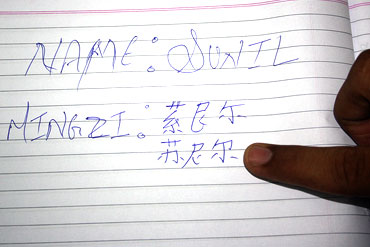 Amit Sakhrani, who runs a language institute in Mumbai, says that of his 30-student strong batch, most are businessmen looking at expanding or those who have expanded their businesses to China.
Amit Sakhrani, who runs a language institute in Mumbai, says that of his 30-student strong batch, most are businessmen looking at expanding or those who have expanded their businesses to China."China is becoming the fastest growing business hub," he says adding that it also helps that the trade relations between the two countries have been improving for a while now.
Excel Academy, Sakhrani's institute, has been around for eight years. He says the demand for Mandarin has been steadily increasing for the last four years.
The course at Excel is divided into six levels. The first four levels are of two months duration each while the last two levels are of three months duration each. The cost of each course is between Rs 5,000 and Rs 6,000.
Over the last few months Sakhrani has noticed a new trend. "Some time ago, a couple came with their two-year-old asking if we could teach him! They said since Mandarin would be the language everyone will be speaking soon, it made sense for their child to start young."
In Kolkata the city that houses the largest number of Chinese immigrants in India many parents like their young ones to start early.
Sunil Kumar, who works for Zhongwen: The School of Chinese Language in Kolkata, says that last year he received over 100 requests from parents who want their children to learn the language. Some of his students are of Chinese origin too.
"The Chinese community in Kolkata speak Cantonese, which is a very different dialect from Mandarin."
"Some of the younger people don't speak Cantonese either. To learn to speak the language of the Chinese, they must learn Mandarin," he says.
While the script can be very daunting, Kumar says learning Mandarin is not very difficult. "It usually takes three years to be fluent in the language. If you are living in China it is even better. People have known to be fluent in as little as a year."
Zhongwen offers a variety of courses for students of the Chinese language -- from a one-month long basic course for tourists (Rs 4,500) to a three-year intensive one (Rs 26,000 per year).
It also offers a joint certificate course in association with the University of Calcutta. The eight-month long course is subsidised and costs Rs 800 per month.
 The career prospects after learning Mandarin are many. Naresh Pratap Singh of New Delhi Languages says you could become an independent translator or simply join a firm that is looking at establishing a base in China.
The career prospects after learning Mandarin are many. Naresh Pratap Singh of New Delhi Languages says you could become an independent translator or simply join a firm that is looking at establishing a base in China."There are many Indian companies looking to trade with China today and are always on the lookout for people to translate for them."
He adds that while graduation in any stream and a good working knowledge of the language will do just fine, a degree in engineering or business management enhances the prospects manifold.
"If you have an MBA you can easily start off with a package of Rs 3.5 lakh to Rs 4 lakh (Rs 350,000 to Rs 400,000) per year."
The course at New Delhi Languages is divided into three modules of 60 hours each with a batch of not more than 12 students. These models essentially equip you in conversational skills and cost Rs 8,500 each.
According to Amit Sakhrani from Excel Institute in Mumbai, the going rate for translation can range anywhere between Rs 3 and Rs 6 per word.
"Depending on how good you are, you can easily make Rs 30,000 to Rs 50,000 per month," he says.
"Our students have been absorbed by various multinationals like Oracle, HCL, American Express, TCS, Infosys, Huawei, ZTE and many others."
"The pay can be as high as Rs 60,000 per month," he says. "If you have an IT, finance or economics background, it adds to your market value."
Although it isn't a very popular option, teaching Mandarin in departments and centres of Chinese at various Indian universities is something that Dr Deepak says is well worth considering.
"To become a lecturer in any Indian university, you must have a master's degree and should have cleared the National Entrance Test."
The Union Public Service Commission also advertises for translators in various ministries.
A recent advertisement for the Ministry of External Affairs seeks applications for the post of a junior translator. To apply you must have one of the following:
A master's degree in the Chinese language with English as a compulsory or elective subject at the degree level from a recognised university.
Or any bachelor's degree with English as a compulsory/elective subject from a recognised university and a diploma equivalent to interpretership standards in the Chinese language from a recognised university along with three years' experience as a translator/interpreter in the Chinese language to English/Hindi and vice-versa or in teaching the Chinese language.
For those who are seriously inclined towards studying the language, Dr Deepak recommends university courses that introduce you not just to the language but also the culture of China.
Dr B R Deepak points out that the growth in demand for learning Mandarin has seen a lot of Chinese language institutes mushrooming across the country. He tells us of the Chinese language courses offered at the Jawaharlal Nehru University:
"The BA and MA courses at JNU are for three and two years respectively. Being a central university, the course is highly subsidised (about Rs 600 per semester).
 There are a couple of entry points to the courses, but the minimum requirements for the BA course are a 10+2 education.
There are a couple of entry points to the courses, but the minimum requirements for the BA course are a 10+2 education.Minimum requirements for the MA course are a BA in Chinese or a three-year equivalent.
Since these courses are in demand, the cut-off for the BA course is usually as high as 90 per cent at the 12th grade.
Prospective students are tested on their general knowledge, mental reasoning and language ability.
If you attend classes regularly there shouldn't be any reason why you cannot be fluent in Mandarin Chinese in three years," he says.
Some others universities/institutes Dr Deepak recommends for learning the language:
- Bharatiya Vidya Bhavan's Jawaharlal Nehru Academy of Languages offers condensed courses in Chinese. The classes for the first semester are conducted during June-July. Students passing the examination in July can join the second semester in August.
Bharatiya Vidya Bhavan, Kasturba Gandhi Marg, New Delhi 110001. Tel: 011-23382005/ 23389942. - Visva Bharati University, Shantiniketan, West Bengal offers two year MA Courses in Chinese as well as a four-year BA (Honours) Course.
Visva Bharati University, Santiniketan, Birbhum, West Bengal 731235. Tel: 03463-262751/52/53/54/55/56. - University of Delhi offers certificate and diploma and advanced diploma courses in Chinese. Each of these are one-year part-time courses. The minimum requirement for the certificate course is a Senior School Certificate of the CBSE or an equivalent qualification.
Department of East Asian Studies, University of Delhi, Delhi 110007. Tel: 011-27666675, 27667725.
Thursday, December 2, 2010
Travel: The lesser known Himalayas
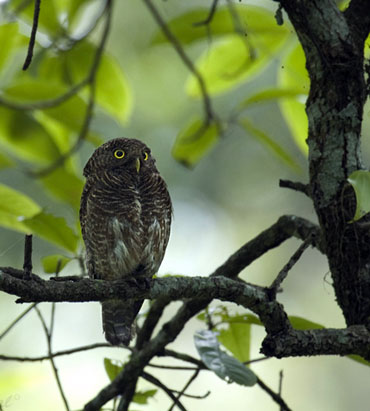
A jungle camp in a dense forest at the foothills of the Himalayas, forlorn, with sunlight as the only source of illumination. At night, only the flicker of a torch or a lantern shows you the way. Constant cries of crickets and rain in spurts create an atmosphere of mystery and intrigue. This is not a scene from a murder mystery movie but very real. If you want to experience this reel life experience, visit the Jungle camps of Help Tourism situated at the Chilapata Wildlife Sanctuary in North Bengal's Dooars region.
Help Tourism is not just about 'visits' organized for the urban-weary but an overall social and economic development effort in these remote locations at the Himalayan foothills.
Most of the tourism destinations, initiatives and projects in these areas include biodiversity hotspots on the international border are isolated from the mainstream and often breed conflicts because of poverty and ultimately stokes destruction of rich natural resources.
These hotspots are the last habitat for flagship species like the Royal Bengal Tiger
These hotspots are the last habitat for flagship species like the Royal Bengal Tiger, Clouded Leopard, Asiatic Wild Water Buffalo, Red Panda, Golden Langur, Hoolock Gibbon, Asian elephant, one horned Rhinoceros, innumerable species of birds, reptiles and amphibians etc.
Help Tourism has been trying to develop the remote areas of Eastern Himalayas with the motto of sustainable tourism. Asit Biswas, managing director, Help Tourism, believes that linking protected areas and heritage with people's livelihood and giving them ownership through tourism is a first step towards conservation and sustainable development in Eastern Himalayas.
The inhabitants of these areas have rich traditions and unique cultures. Biswas, who is familiar with the place and people of the region, feels that without the cooperation and support of the local people he could never have succeeded in his efforts.
"We have seen that tourism is a tool to open a global window in these neglected areas. The arrival of tourists helps to eradicate the feeling of isolation in the people and the appreciation from visitors for their natural and cultural resources develops a sense of pride in them. The economic benefit and administrative attention brought in by the visitors also balances the rich traditions and conservation initiatives by the local communities," he says.
There are exotic tourist bases in the entire Eastern Himalayas
Today, there are exotic tourist bases in the entire Eastern Himalayas. From Manas Tiger Reserve in Assam,Singalila National Park, Darjeeling, Namdapha Tiger Reserve and Mehao Wildlife Sanctuary in eastern Arunachal Pradesh, Neora Valley National Park, Kalimpong, to Chilapata Wildlife Sanctuary, Dooars, initiatives are taking place to transform these remote areas into attractive tourist destinations.
The developers are not only focused on promoting tourism but have also made efforts to turn poachers and terrorists into protectors of nature and social leaders by changing their attitude and aim for a better life.
This has been possible by engaging them in the entire process of development and conservation.
Nurul Hassan, a local youth who now works as a guide at the Mehao Wildlife Sanctuary, says, "There has been a radical change in the youth force, which now takes pride in conserving their traditions and relate themselves globally; hence the end of isolation. International travellers attract the attention of the local administration which then tries to bring in development activities around the destinations."
At these destinations, there are community associations or organizations which look after the protection of local flora and fauna in the designated Tiger Reserves, National Parks or Wildlife sanctuaries. All that the visitors have to do is to subscribe to a temporary membership or visit the areas with the local community associations and participate with the local members in the several protection activities.
The under-travelled Northeast
Our destinations not only motivate the visitors, but move them to act responsibly in their future travel decisions. The local communities at the sites are an integral part of the Help Tourism initiatives. They are the principal stakeholders in the tourism initiatives and benefit financially, socially and spiritually," informs Biswas.
Meenakshi Subramaniam, a tourist from Kerala, corroborates: "I have travelled alone in some of the most remote parts of the Himalayas using Help Tourism. The whole philosophy of holistic and community beneficial tourism is epitomised by the tours offered."
She has visited Manas, an important tiger habitat in lower Assam, Kaziranga as well as Dibru Saikowa/ Mishmi Hills in the North East, all of which have several local and indigenous tribes and communities. "Every community member I have met through my travels has been friendly and helpful," she enthuses.
Mikey Leung, a travel writer, says: "By taking tourism and its benefits to some of the most vulnerable and least understood destinations our planet has to offer, particularly the under-travelled regions of Northeast India, these organizations do what few other companies are willing to do: to put tourism profit and social development on the same agenda."
Spiti: The Middle Land
Spiti Valley, a desert mountain valley in Himachal Pradesh, is another less explored tourist destination. Located between Tibet and India, Spiti is often called "The Middle Land".
Nestled in the trans-Himalayan range, Spiti is a high altitude desert region with an arid landscape, scarce vegetation and a six- month-long cold winter (temperatures dip to 30 degree centigrade) allowing cultivation of only one crop a year. Spread over more than 7,000 sq km, Spiti gets isolated during the winter due to thick layers of snow.
Promoting this less known treasure of nature is an initiative by Ishita Khanna and Sunil Chouhan who have named their initiative 'Spiti Ecosphere'. It is a collaborative effort of the local community of Spiti and professionals from diverse backgrounds.
Ecosphere aims at the sustainable development of the Spiti valley by linking economic empowerment, conservation and development. Says Khanna, "Ecosphere works on synergizing the multitude of livelihoods available to the local community. On one hand, it reduces over-dependence on one particular livelihood and on the other, ensures the conservation of the region's natural and cultural diversity."
The magnificent Himalayas
Adds co-founder Chouhan, "In tandem with its core philosophy, Ecosphere has focused most of its efforts on developing options that tap the local surpluses and unique attributes of Spiti. One such surplus identified was Sea Buckthorn (a wild berry with high medicinal value). The other high potential livelihood avenue that emerged was eco-tourism."
Moreover, by developing markets for indigenous crops such as barley and black peas, Ecosphere is attempting to promote and thereby revive the cultivation of indigenous crops which are more suitable to the area's geo-climatic conditions as well as protecting the organic practices of the region.
Rachel Parry, a European tourist who visited Spiti, agrees: "My time spent in Spiti Valley working with Ecosphere was not only extremely rewarding but also a huge personal achievement. I met incredible people and visited some breathtaking places. I couldn't believe the enthusiasm the monks and masons had, and their willingness to teach and work with us, even with the language barrier." She also gained some 'added extras' "which I personally had not expected - friendship, local knowledge, guidance and chocolates!"
The magnificent Himalayas have enchanted and fascinated travellers from all over the world for ages. Today, promotion of the less explored areas at its foothills has only added to its enchantment.
Subscribe to:
Posts (Atom)



